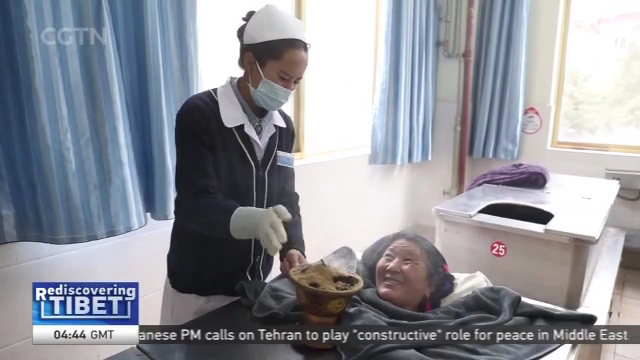
13:51, 13-Jun-2019
Tibet: A journey through time: Medicinal bathing therapy dates back thousands of years
Updated
17:31, 09-Jul-2019

Let's continue with our series on the development of Tibet. Tibetan medicinal bathing is a type of therapy that Tibetan people have adopted to treat various illnesses. With a long history of nearly four thousand years, the practice was added to the Representative List of the Intangible Cultural Heritage of Humanity, in November last year. As its influence grows, a concern is how to properly promote the practice. CGTN reporter Yang Jinghao has more.
This is not recreational bathing in a public bathhouse. It's a unique therapy known as Lum medicinal bathing of Sowa Rigpa. For thousands of years, many Tibetan people across China have relied on it for the prevention and treatment of various illnesses.
LOBSANG DOLMA PATIENT "I am 71 years old. I have kept seeking this treatment regularly since I suffered diabetes years ago. It can effectively relieve the symptoms of related complications."
Migdrol is from this Tibetan medicine hospital in Shannan Prefecture. He is a master of this time-honored medical practice, which involves traditional Tibetan astrology, religion, and other aspects of daily life.
Over the past few decades, he has witnessed its evolution and ever-increasing popularity.
MIGDROL TRADITIONAL TIBETAN MEDICINE DOCTOR "Through the bathing, nutrients of the herbs can be easily absorbed by blood capillaries, and the toxins inside the body will be sweated out, thus balancing the patients' endocrine system and boosting immunity. The treatment has no bad side effects on the human body."
To produce the medication is a long process that involves unique techniques.
Several native wild herbs need to be repeatedly boiled and fermented before the "essence soup" is ready.
Today, modern techniques are also integrated to facilitate the production, such as in Tibet's largest traditional Tibetan medicine hospital in Lhasa.
DOLMA TRADITIONAL TIBETAN MEDICINE DOCTOR "We set up a special extraction workshop two years ago. In the past, each step was finished manually. With modern extraction equipment, now the output of medication greatly increases and its efficacy also improves."
YANG JINGHAO LHASA, TIBET "The centuries-old therapy is expected to see a growing global influence after it was added to UNESCO's world intangible cultural heritage list. But more effort lies ahead before the practice can be spread to larger areas beyond Tibet."
Both Migdrol and Dolma say they hope the treatment can be enjoyed by a wider range of people, but the raw materials pose a challenge.
MIGDROL TRADITIONAL TIBETAN MEDICINE DOCTOR "All the herbs are indigenous. Tibet is abundant in various herbs, but the vegetation on the plateau is also weak, so the supply of medicinal materials will be a problem for wide promotion."
In fact, as the influence of the therapy expands, many medical practitioners now have a concern – over-commercialization – which they think will damage the authenticity of the tradition and harm the plateau's ecological environment.
In this regard, a scientific industry guideline is anticipated, to ensure the medical practice is properly developed.
SITEMAP
Copyright © 2018 CGTN. Beijing ICP prepared NO.16065310-3
Copyright © 2018 CGTN. Beijing ICP prepared NO.16065310-3